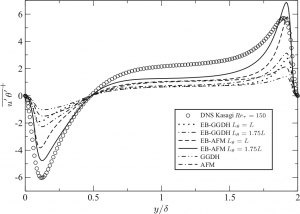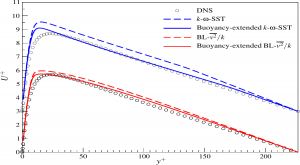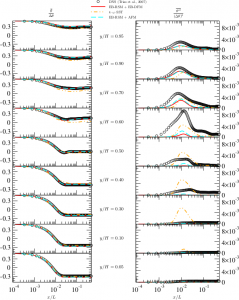When buoyancy has an influence on the dynamics, it is very important to represent in a very realistic manner not only the turbulence and its anisotropy, but also the turbulent heat flux. This problem is very important for many industrial applications.
The models used in industrial codes are based on assumptions that are far too restrictive. Within the framework of the second-moment closure using elliptic blending, which closely represents the anisotropy of dynamic turbulence, it is possible to solve transport equations for the turbulent heat fluxes by imposing, through elliptic blending, a correct asymptotic behavior of these fluxes in the vicinity of the wall (EB-DFM, Elliptic-Blending Differential Flux Model).
Since 2005, with two successive CIFRE PhD theses (Lecocq, 2008 ; Dehoux, 2012), we have worked in collaboration with EDF on the improvement of this approach, either by simplifying it by adopting an algebraic version (Dehoux et al.) or by improving the prediction of natural convection cases by taking into account mixed time scales in the turbulent dissipation equation (Dehoux et al., 2017). We have also developed a simplified approach for eddy-viscosity models in collaboration with PSA Group (now Stellantis).
Algebraic modeling of the turbulent heat fluxes
 Profile of the vertical turbulent heat flux in a differentially heated channel flow. EB-RSM associated to different algebraic models for the turbulent heat flux. From Dehoux et al. (2012).
Profile of the vertical turbulent heat flux in a differentially heated channel flow. EB-RSM associated to different algebraic models for the turbulent heat flux. From Dehoux et al. (2012).
Second-moment closure of the turbulent heat fluxes
Flow in a differentially heated cavity of aspect ratio 4:1. Profiles at several heights of the mean temperature and the temperature variance. Comparison of the results obtained with different models for the Reynolds stresses and the turbulent heat fluxes.. From Dehoux et al. (2017).
Extension to buoyancy effects of the linear eddy-viscosity models
 Mean velocity profiles in a differentially heated vertical channel flow. Effect of the introduction of a buoyancy term in the Boussinesq relation. From Jameel el al.(2019).
Mean velocity profiles in a differentially heated vertical channel flow. Effect of the introduction of a buoyancy term in the Boussinesq relation. From Jameel el al.(2019).




